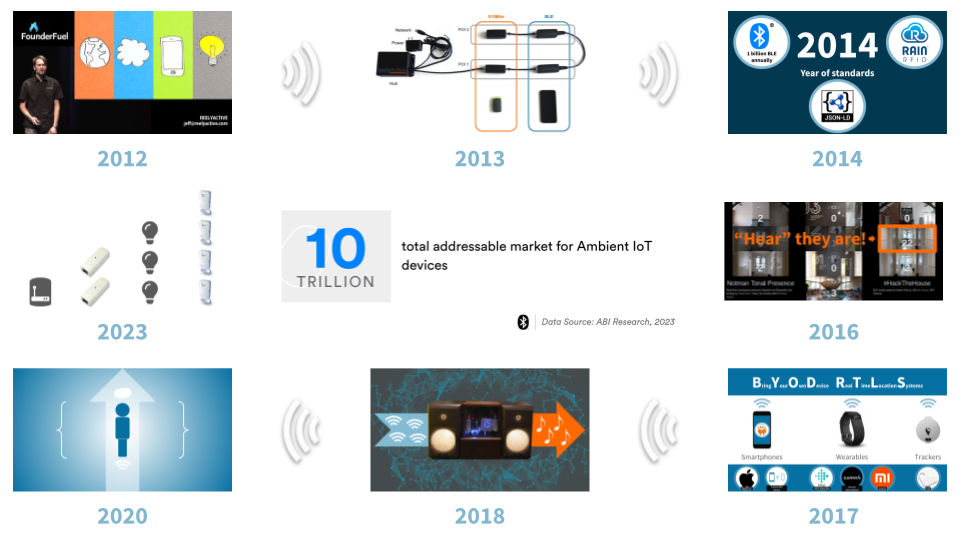The recently released 2023 Bluetooth Market Update includes as a “Driver for Tomorrow” what the SIG calls Ambient IoT.

To celebrate IoT Day (today, April 9th), we thought it would be fitting to reflect on how the concept of ambience became intertwined with the Internet of Things (IoT), in the form of a brief history from our own unique perspective.
Identifiable, not necessarily connected
We start our story in 2012 when, as reelyActive was graduating from the FounderFuel accelerator, Cisco announced the “Internet of Everything,” predicting 50 Billion things by 2020. We were dumbfounded by that number: why was it so low?!?
Having cut our teeth in Active RFID for the better part of the 2000s, the reelyActive co-founders considered anything automatically identifiable (i.e. by radio-frequencies) as counting towards the nascent IoT, with predictions already in the Trillions. While the early IoT hype bubble was all about connected things, we were already building for the identifiable things that would weave themselves into the fabric of life all around us.
Ambient infrastructure
Of course trillions of identifiable things need to be identified, and that requires infrastructure. Everywhere. And that’s the problem we were solving early on with our novel reel architecture, which we published at the IEEE Local Computer Networks conference in 2013.
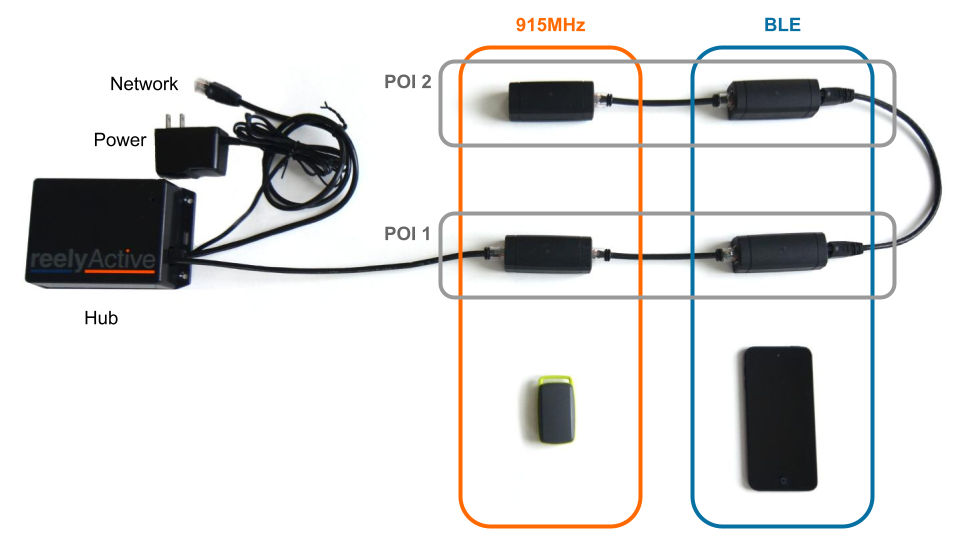
The concept is simple: a reelceiver converts radio packets from identifiable things into standard serial packets on the wire, which can be consumed and relayed by any computer. At the conference in Sydney, we demonstrated Active RFID and Bluetooth Low Energy devices being not only identified—but also located—using a single modular infrastructure.
The Apple Advertising Event
It’s timely to mention Bluetooth Low Energy (BLE), because by 2014, it had become the de facto global standard for Active RFID, with a Billion devices shipping that year alone. And that same year something truly ambient would happen: millions and millions of Apple devices suddenly began to spontaneously transmit BLE advertising packets to discover and interact with one another.
I (Jeffrey Dungen, reelyActive co-founder and CEO) remember a day in May 2014 when I thought our BLE reelceivers developed a bug because they started spitting out an unprecedented amount of packets. I discussed this with a friend and neighbour who exclaimed to me:
“Hey, did you notice that Apple devices just started advertising, like all the time?”
I would love to know if Apple had a code name for that day, or if they realised its significance beyond their own ecosystem of devices. We simply took to calling it the Apple Advertising Event.
People, not Things?
Of course, around that time, BLE radios were finding their way into higher-end personal electronics such as smartphones and wearables, which were carried by people. And the ambient BLE packets transmitted by those personal devices were primarily at the service of the people themselves. The Internet of Things was looking more like an Internet of People, for which we were pioneering what, back then, we called BYOD RTLS.
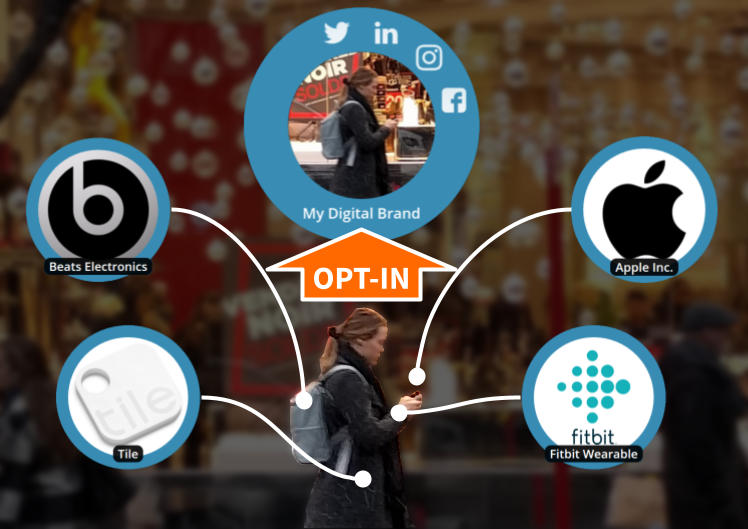
Realising the potential, we developed initiatives such as our reelyApp, which allowed users to Advertise[themselves] with the Physical Web. The one-liner on our web page became “We unlock the value of the data you choose to share” enshrining a user-centric value proposition for the Internet of Things (and People), where anyone or anything could share ambient data at a human scale, with the expectation of contextualised experiences in return.
Ambient sounds about right
The term ambient is often associated with sounds or music, and so it was natural for us to collaborate with artist Evelyne Drouin in 2018 to create Présences Périphériques: “an installation that gives sonic presence to interconnected apparatuses worn by viewers within a space.”
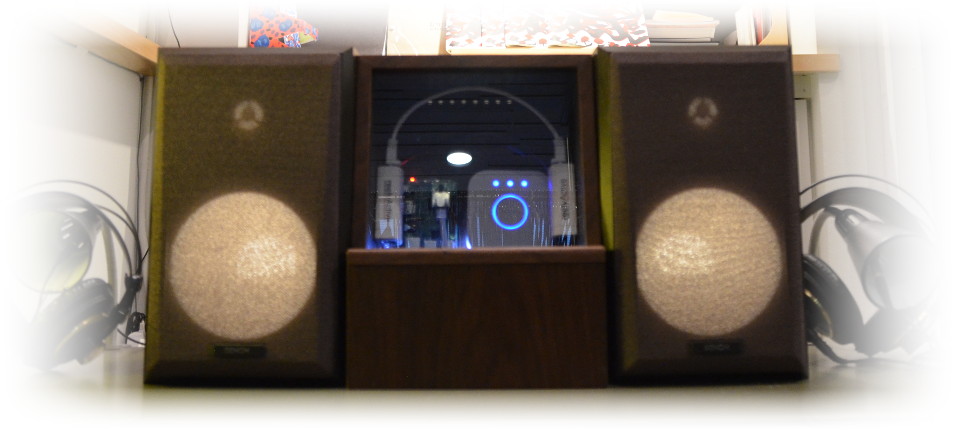
Exhibited as contemporary art at Centre Clark, the installation provided us the opportunity to observe individuals’ initial reaction to discovering that they could “sense” ambient radio-identifiable things around them—in particular their own personal devices!
The one-liner on our web page had fittingly become “Embrace the ambient data in your space” which coincided with the ambient technology concepts we discovered in Malcolm McCullough’s Ambient Commons.
A sense of things to come
Fast-forward to this year (2023) in which we’ve already seen the realisation of the elusive $1 Bluetooth beacon. The economies of scale are now such that commodity sensors, including temperature, motion, magnetic contact, illuminance, etc., can join us throughout the spaces in which we live, work and play. In 2020 we added a data type called dynamb, for dynamic ambient data, to our open source middleware, which represents, in a standard, vendor-agnostic way, how all these “things” sense real-world context.
The next breakthrough in price point and proliferation is likely to come from energy harvesting technologies such as Wiliot, which promise stick-on-anything capability with unlimited battery-free autonomy. Of course that’s the same promise as RAIN RFID (a mature technology that has already shipped about 150 Billion devices), but with the advantage that the required ambient BLE infrastructure is actually nearing ubiquity.
Ambient infrastructure 4.0
And that brings this blog post full circle to our initial raison d’être: infrastructure. Fortunately, these are exciting times for ambient infrastructure, such as the WiFi access points that we’ve come to expect to provide us connectivity everywhere, as we explain in our recent Infrastructure 4.0 post (many support BLE). The problem that reelyActive is solving today is how to make any physical space context-aware by harmonising the heterogeneous mix of ambient devices and ambient infrastructure already present in that space!
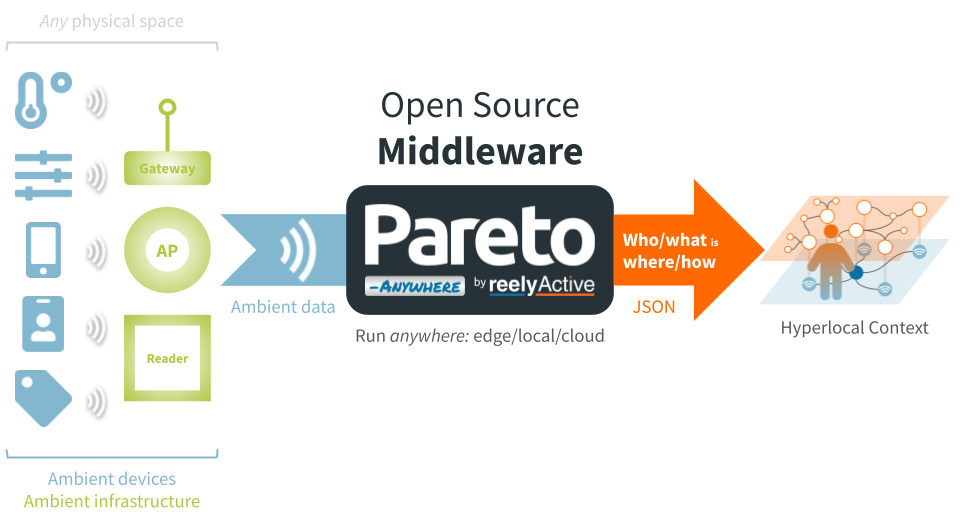
Time will tell whether the term Ambient IoT best describes the next evolution of what started 50 years ago as automatic identification and data capture (AIDC). But there are hundreds of billions (currently counting just BLE & RAIN RFID) and soon trillions of reasons to argue that the technology has already become invisibly omnipresent, and hence ambient, in our daily lives.
Happy IoT Day 2023!
